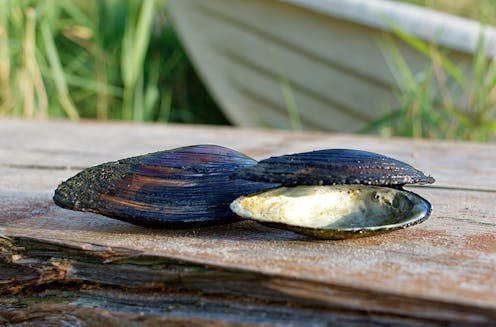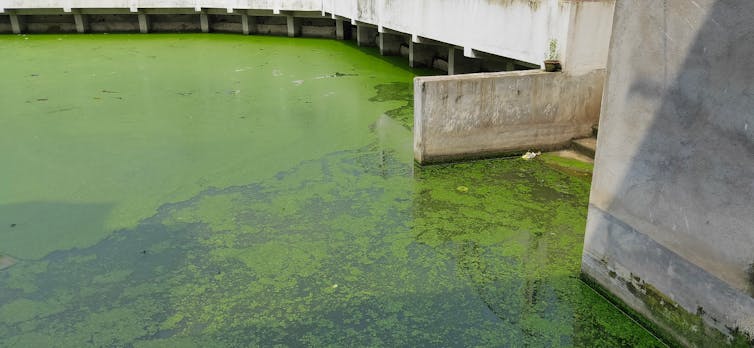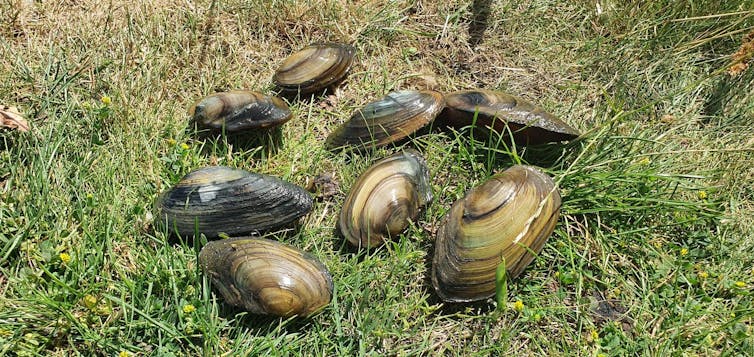
Freshwater ecosystems, including rivers, are home to 10% of all known animal species. Yet at the same time, they are losing their species diversity faster than any other ecosystem type globally. Because species of animals respond to different threats in various ways, it makes it difficult to assess the health of these river systems.
But the population status of species such as freshwater mussels can reveal wider trends in the ecosystem. Freshwater mussels live in riverbeds and feed by filtering algae and other organic particles from the water. As they burrow into the riverbed and remain largely stationary, they are exposed to many of the stressors threatening rivers and are therefore a useful indicator the health of the river in which they live.
Mussels also serve as ecosystem engineers. They maintain clear water and prevent the development of harmful algal blooms. They also promote freshwater biodiversity by providing habitat and nutrients for riverbed invertebrates. Freshwater mussels are among the most threatened animal groups in the world. Yet in Britain we have little information on the health of these species.
I participated in a recent survey which evaluated the population status of freshwater mussels in the River Thames. We found an alarming deterioration in the number and size of the mussels, which could harm the health of the river ecosystem. But some of the changes we observed may be the outcome of efforts to return the River Thames to a more “natural state”.
The river’s mussels under threat
One influential survey, carried out in 1964, underpins much of our understanding about freshwater mussels in the River Thames. The survey was one of the first to quantitatively evaluate freshwater mussel populations. It was conducted at a site near Reading by Christina Negus, then a postgraduate researcher from the University of Reading.
Her research found that freshwater mussels represent 90% of living organisms by weight on the Thames’ riverbed. The survey’s findings emphasised the role of freshwater mussels as some of the river’s key species.
Our survey reassessed the population of freshwater mussels along the same stretch of the river and used methods identical to those used by Negus. We found that the population of freshwater mussels has declined by almost 95% since 1964. One species, the depressed river mussel, may have disappeared entirely from the river.
The results of our survey also suggest that River Thames mussels are smaller than they were at the time of the original survey. Their total size and rates of growth have fallen by 10%-35% compared to 1964.
We also identified the presence of an invasive species of mussel, the zebra mussel. Zebra mussels are found across Europe and North America and threaten native mussel species by settling directly on their shells, competing for food, and sometimes preventing a mussel from opening. The presence of the highly invasive Zebra mussel, which was not observed in the 1964 survey, could have contributed to the decline in the overall number of freshwater mussels recorded by our survey.

A cleaner river
Lower levels of nutrients, such as phosphate, in the river may be part of the reason why mussels are smaller and slower to grow than observed in 1964. Nutrients stimulate the growth of algae, a key source of food for mussels. Reduced nutrient content could therefore lead to lower food availability for mussels and slower growth rates as a result.
The Thames was heavily polluted at the time of the original survey. We spoke to Negus, who recalled having a sore throat for the entire two years she conducted her survey, a symptom she attributes to the polluted river. This implies that the size and growth rates of the freshwater mussels recorded in 1964 may have increased artificially due to nutrient pollution from human sources.

But since being declared “biologically dead” in 1957 due to its level of pollution, the Thames has recovered and is now ranked among the cleanest urban rivers globally.
Tighter rules around the release of sewage have resulted in concentrations of phosphate in the River Thames falling considerably since the 1960s. Viewed this way, today’s smaller mussels may be indicative of the river’s return to a more “natural” state.
Changing ecosystem
However, the picture is more complicated than this implies. Invasive species and broader threats to habitat, such as dredging and intensive land use along the riverbank, may also have driven the decline in what were once some of the river’s most abundant animals. So these declines sound a warning about the health of the river’s ecosystems.
Among the mussels experiencing the greatest declines are the duck mussel and the painter’s mussel, the populations of which have declined by 98.9% and 96.8% respectively. Both of these species are generally considered common and are not listed as threatened. There are no monitoring programmes or protections currently in place for these species as a result.

If our findings reflect a wider decline in the status of freshwater mussels in rivers across the UK, then we could be approaching a critical and unexpected population collapse. Such a collapse is likely to have a negative impact on freshwater ecosystems because of mussels’ role in promoting invertebrate biodiversity.
So while a cleaner river is positive for river biodiversity, such severe declines in these once abundant species suggest we should increase our efforts to protect these valuable yet fragile ecosystems.
Isobel Ollard does not work for, consult, own shares in or receive funding from any company or organisation that would benefit from this article, and has disclosed no relevant affiliations beyond their academic appointment.
This article was originally published on The Conversation. Read the original article.







